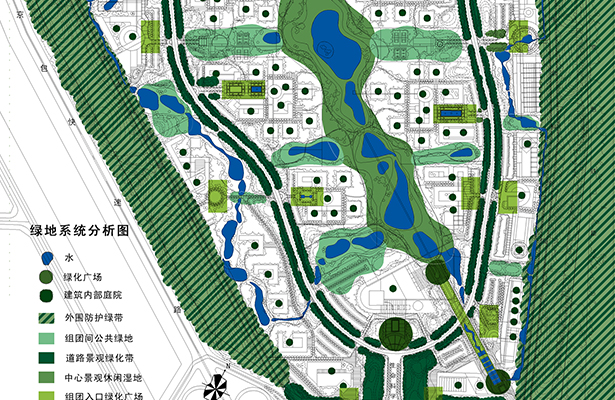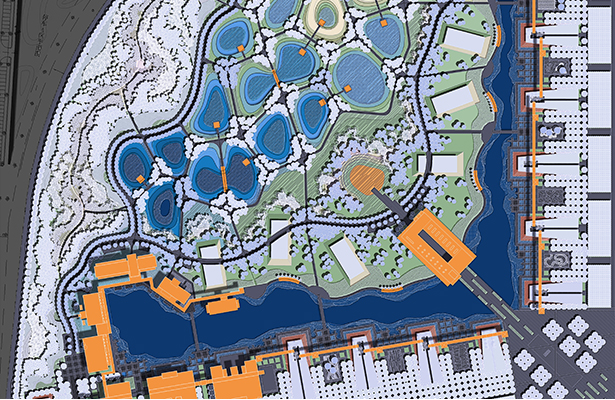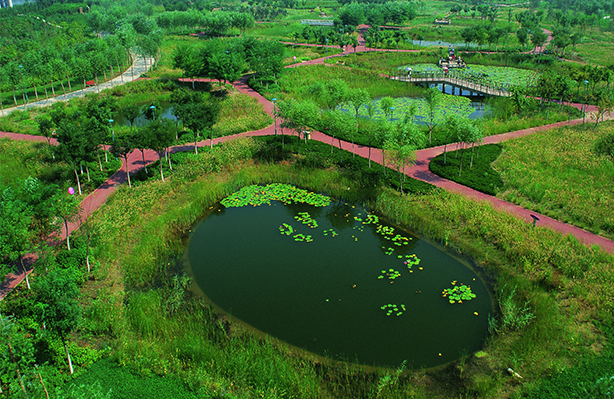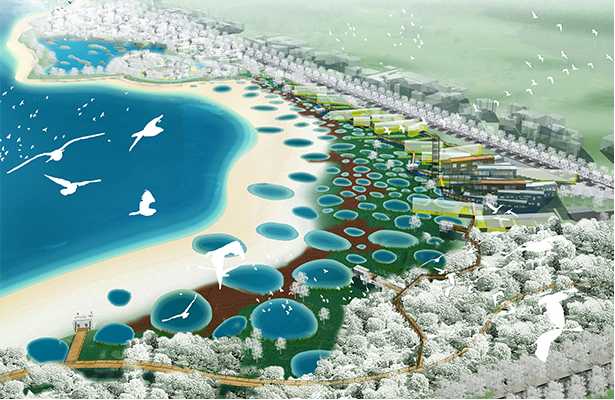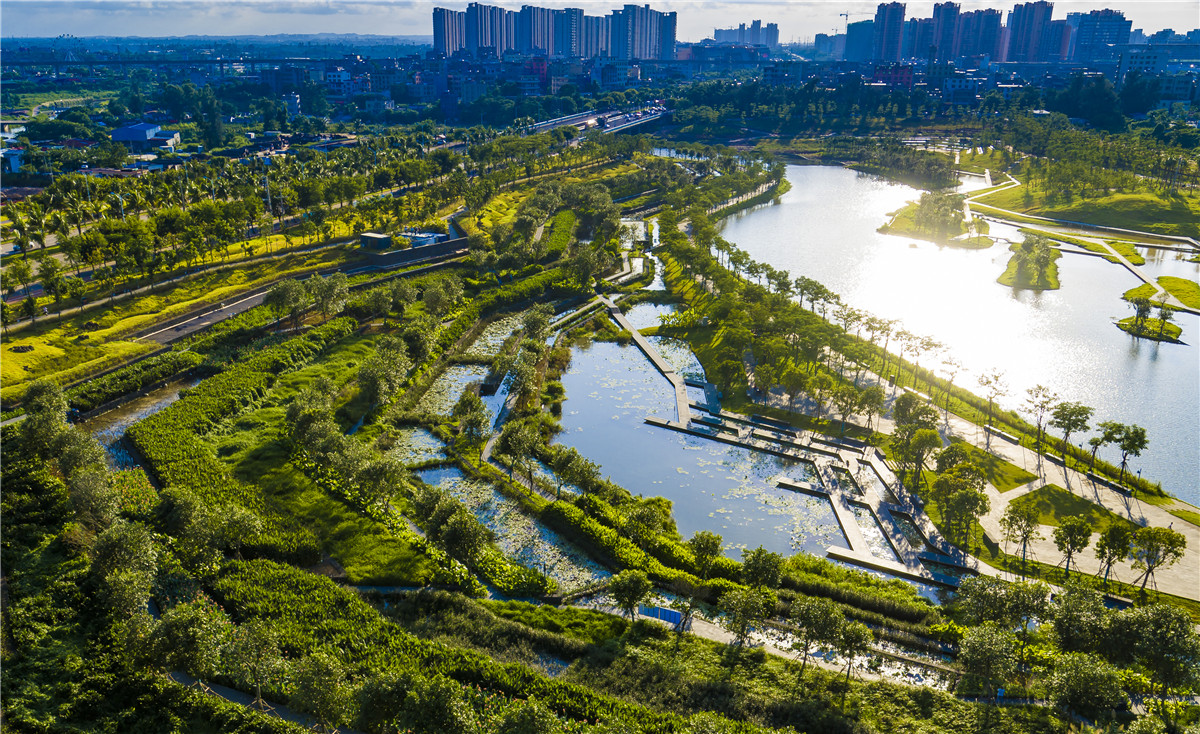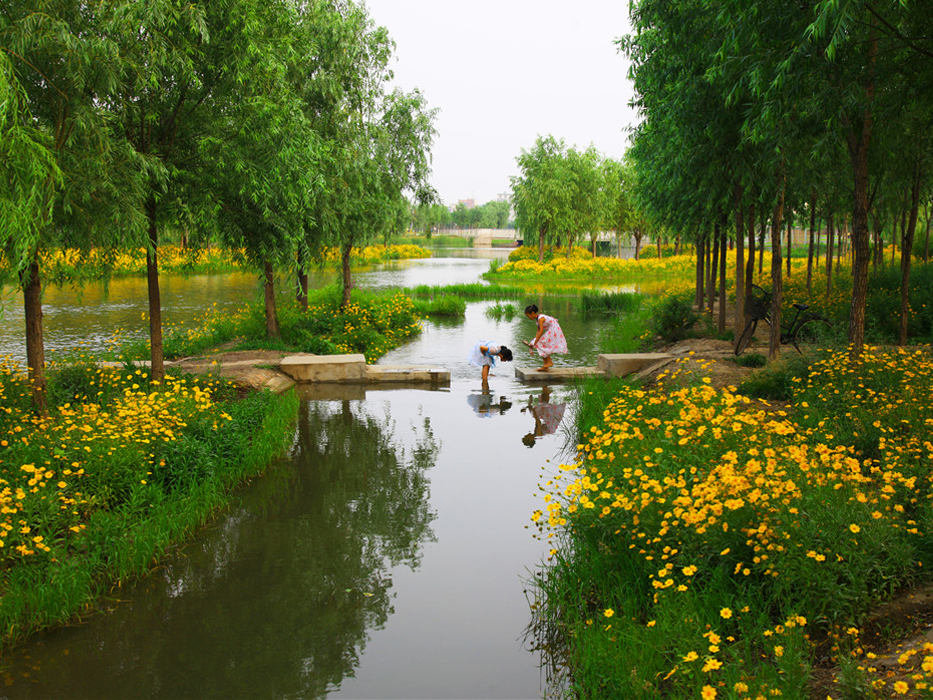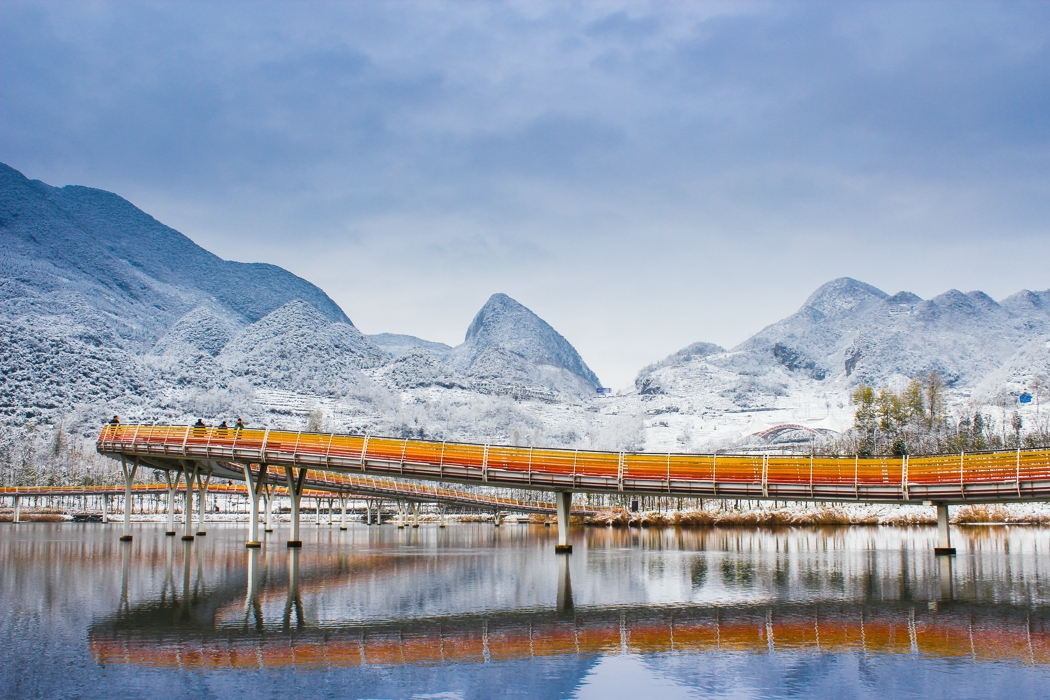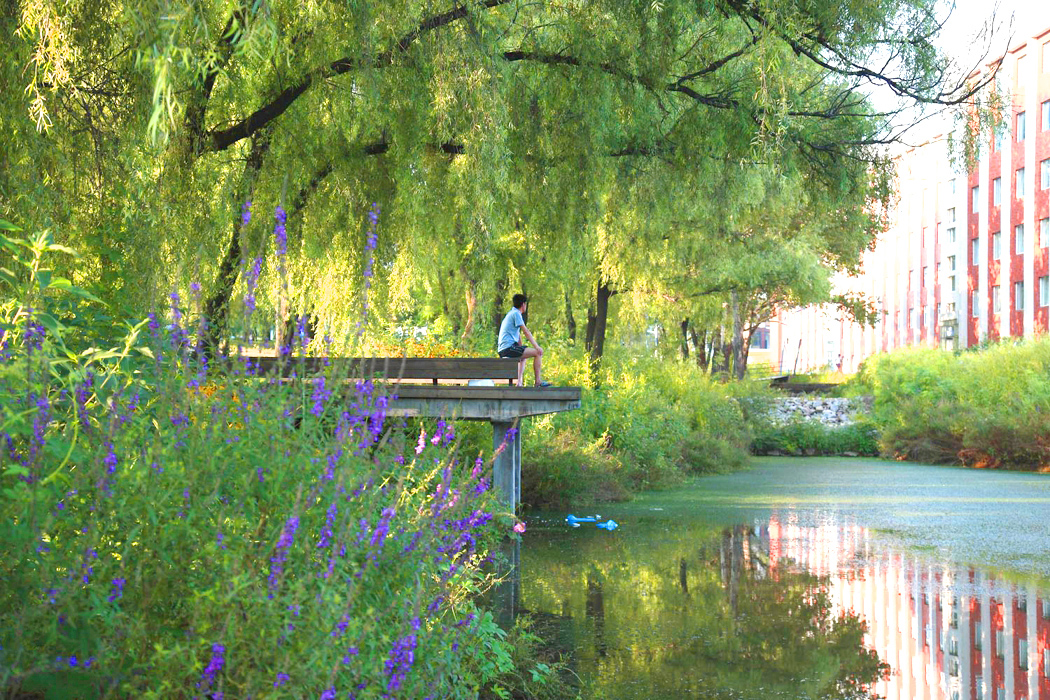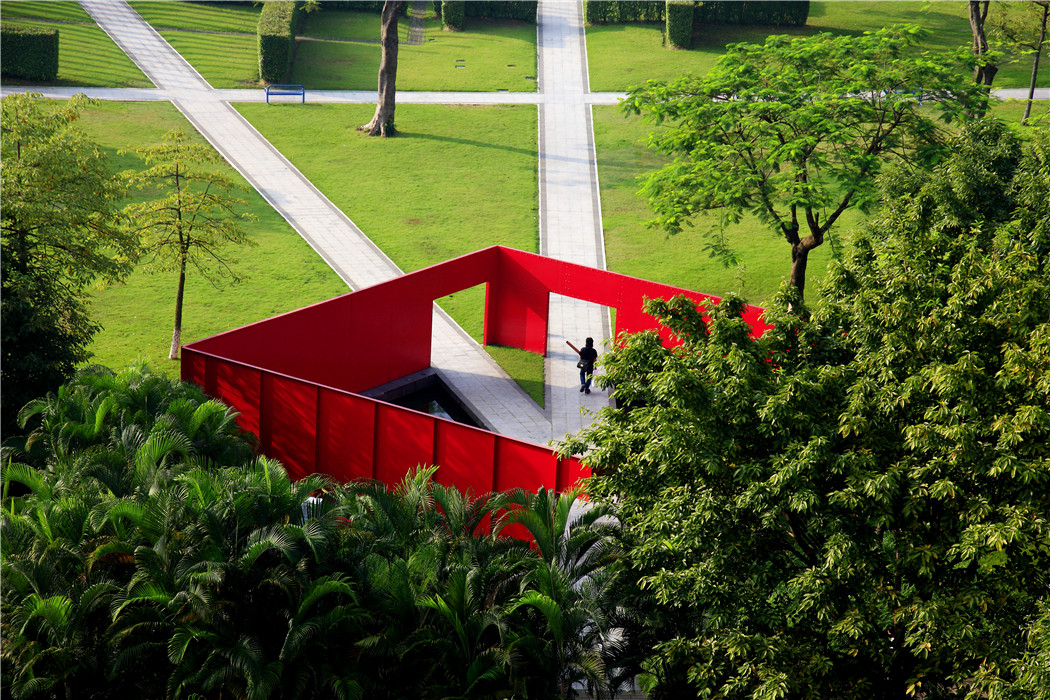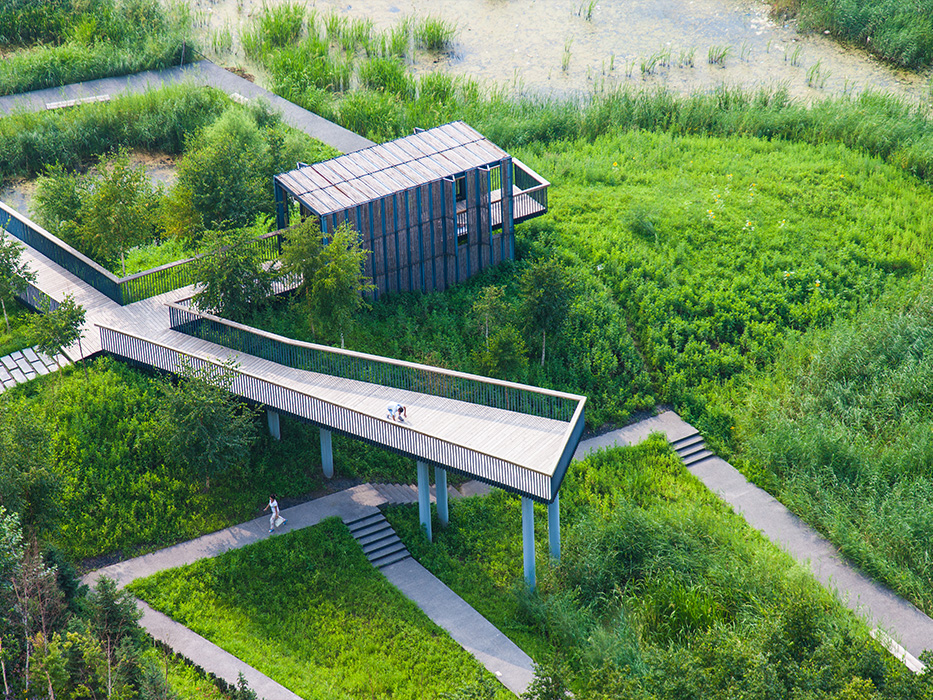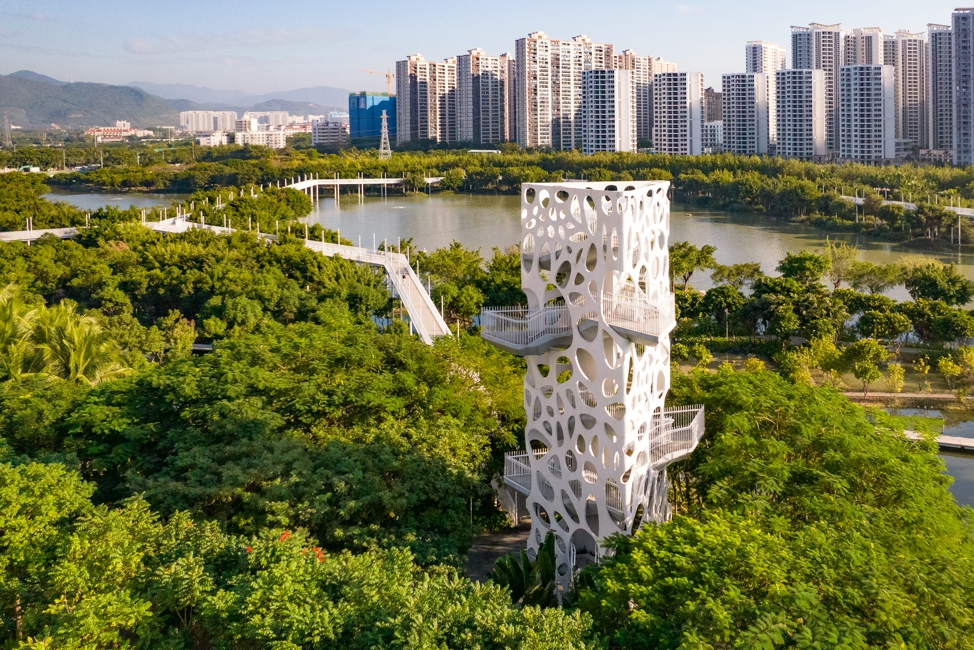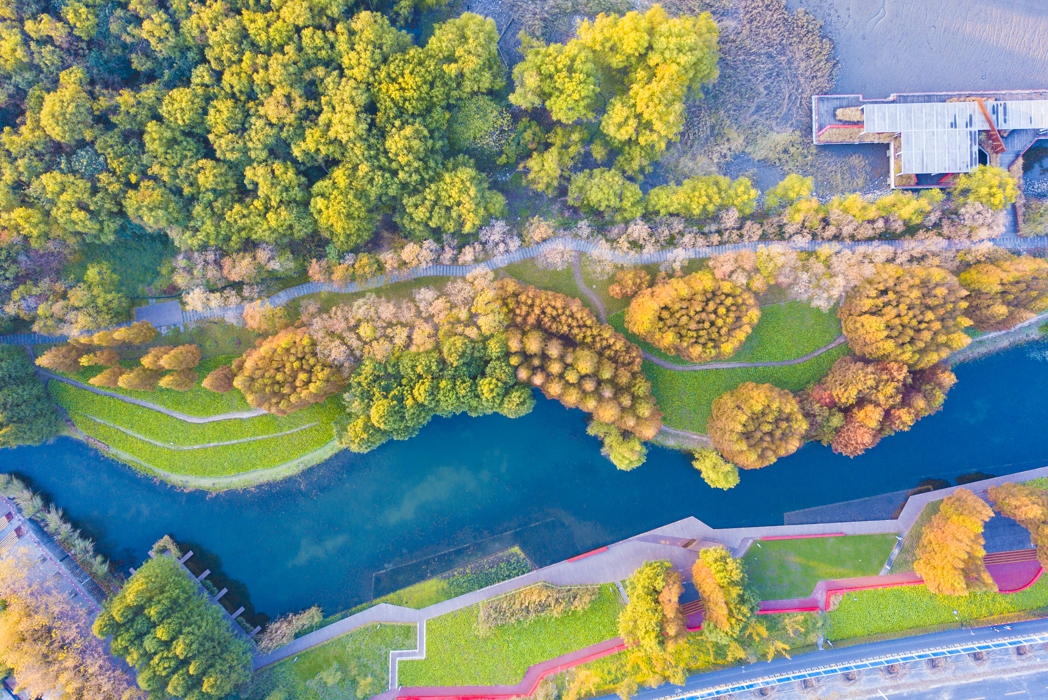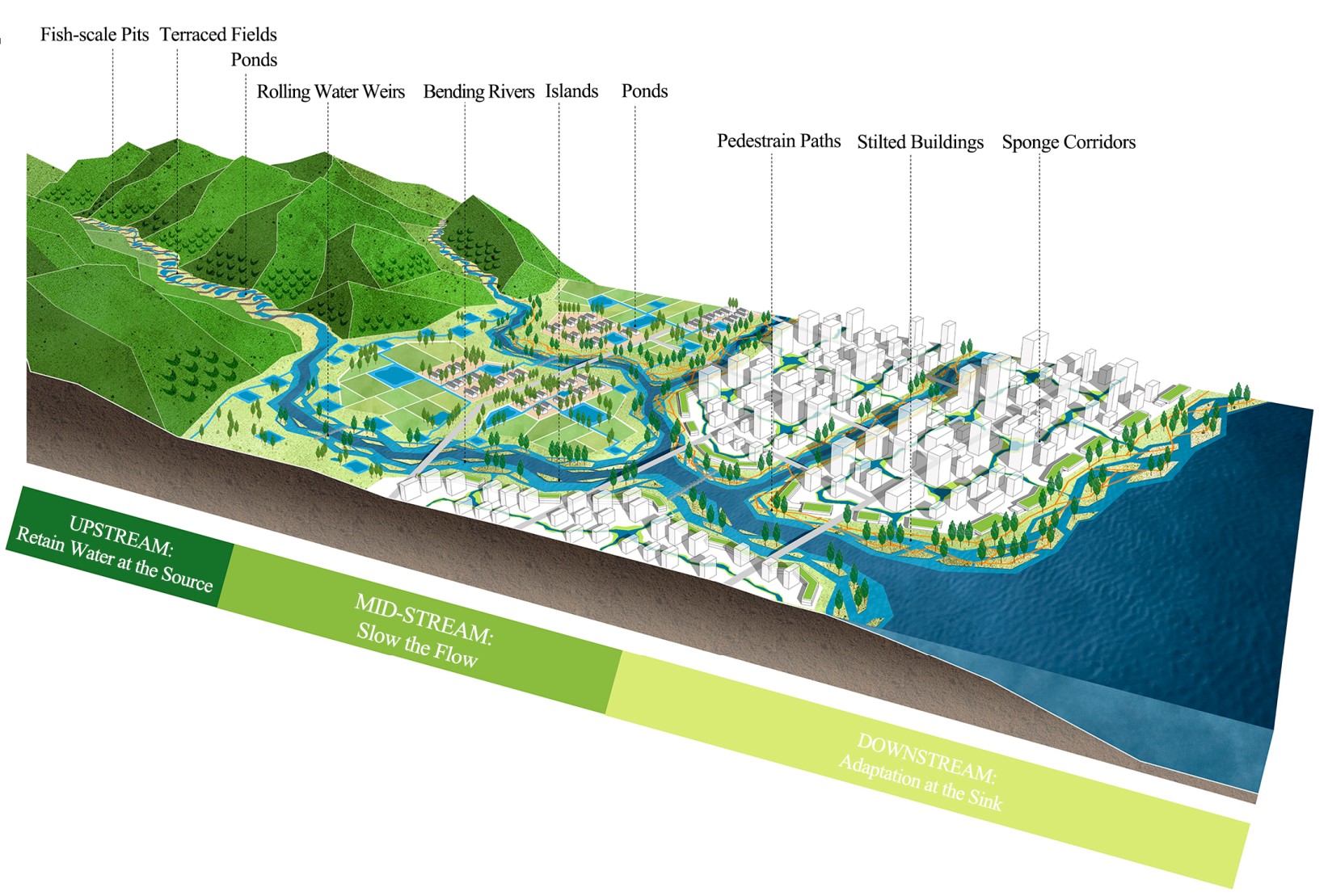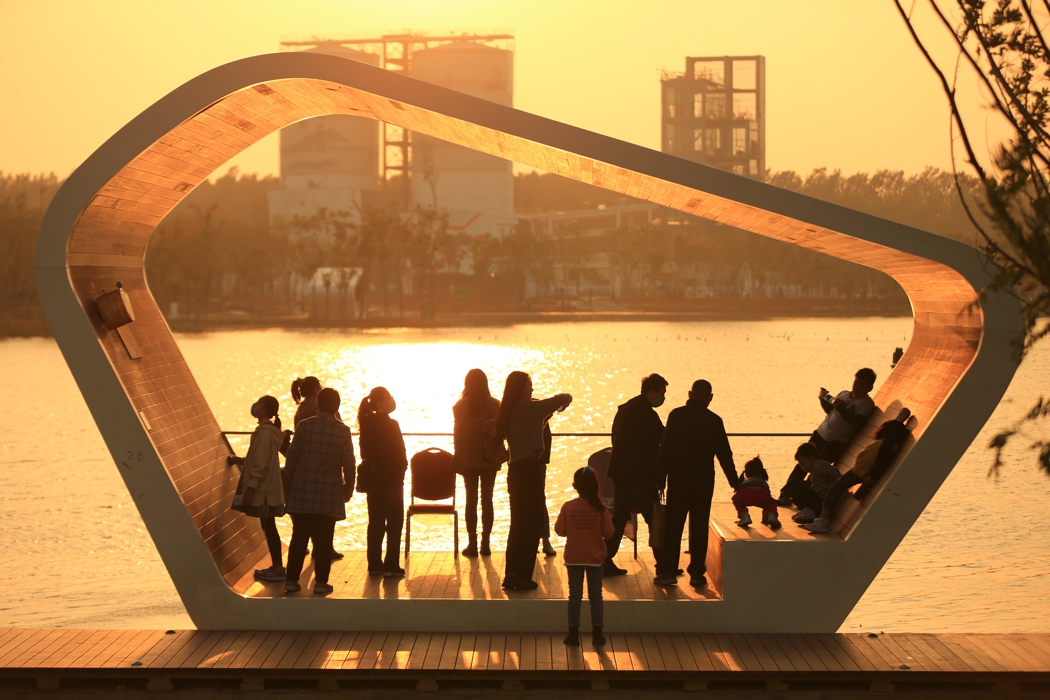

The national government’s decision to invest in the sponge city concept happened relatively quickly, but the groundwork for that transformation leads back to 1997, when Kongjian Yu and his team began focusing their efforts on studying urban water systems (Kongjian Yu,Ye Zheng,1998). They used the concept of a sponge to describe the flood-control capacity of natural systems, pointing out that “the natural wetlands along rivers can function like sponges to retain water during flooding and recharge water during drought” (Kongjian Yu, Dihua Li, 2003). In 2001, Yu and his colleagues proposed "Ten Strategies for Urban Ecological Infrastructure Construction,” which was an early, systematic discussion of ecological stormwater management (Kongjian Yu, Dihua Li, Luomeng Chao, 2001). These strategies emphasize constructing urban ecological infrastructure to safeguard ecosystem services, and two of the strategies were directly related to urban ecological stormwater management, i.e. maintaining and restoring the natural forms of rivers and coasts, and protecting and restoring wetland systems. The article criticized the prevailing phenomenon of river channelization, and the widespread destruction of urban and rural wetlands by urban construction. It emphasized the necessity of providing comprehensive ecosystem services to cities by maintaining and improving river and wetland systems. The principal strategies include clean water provision, drought and flood control, groundwater recharge, diverse habitat preservation, and recreational opportunity provision and aesthetic enrichment for urban residents. In 2004, these ten strategies were incorporated into the Ministry of Construction’s Technical Policy Outline for Construction (Kongjian Yu, Dihua Li, 2004). The ecological infrastructure approach to tackling urban and rural water problems has been applied to the national ecological security pattern planning, the regional ecological planning of Beijing, Taizhou, Weihai, Heze and Dongying, in eastern China, and the ecological planning and design of nearly 200 other cities throughout the country (Kongjian Yu, et al., 2005; Kongjian Yu, Lei Zhang, 2007; Kongjian Yu, Xuesong Xi, Sisi Wang, 2008; Kongjian Yu, Sisi Wang, Dihua Li, et al., 2010; Kongjian Yu, Sisi Wang, Qing Qiao, 2010; Kongjian Yu, Yuan Zhang, Yunqian Liu, 2012; Lin Mo, Kongjian Yu, 2012; Yun Song, Kongjian Yu, 2007). And in the years since, a series of influential urban "sponges" or sponge city demonstration projects have been featured in international publications, as well as winning international awards; Suining(Kongjian Yu,2011), Qian'an (Kongjian Yu,2010), and Xixian New Area(Kongjian Yu,2013), among the first batch of pilot cities for sponge city construction, have applied the sponge city construction theory and technology in their planning and river improvement projects.
A series of earlier projects have also contributed to the exploration and refinement of sponge city construction approaches. The first was Beijing Zhongguancun Life Science Park, built in 2000. It introduced a green space system called "earth-life cells," which utilize constructed wetlands to collect rainwater and purify reclaimed water (Kongjian Yu, Dong Zhang, 2001; Kongjian Yu, Dihua Li, Yafan Meng, 2001).
The second was Zhongshan Shipyard Park near Guangzhou, constructed in 2001, which created a resilient waterfront with trestle. (Kongjian Yu, Haibo Hu, Jianhong Li, 2002). During 2002 and 2003, as part of the ecological restoration of the Yongning River in Taizhou, on the eastern coast, concrete embankments were replaced with flood-friendly and flood-adaptive ecological riverbanks and wild grass revetments, which also restored habitats for wild animals and plants (Kongjian Yu, Yujie Liu, Dongyun Liu, 2005; Graham Johnstone, Xiangfeng Kong, 2007). In the design project for the Jianzhu University campus in Shenyang, in northeast China, rice fields were introduced, which can be irrigated by rainwater collected on the campus (Kongjian Yu, Yi Han, Xiaoye Han, 2005; Paisajismo, 2007). Also in 2005, in the phase II design of Qinhuangdao Tanghe Park, a “red ribbon” (500-meter long bench) helped transform the neglected and overgrown floodplain into a popular urban park, using a minimum intervention strategy, rather than traditional concrete embankments. The park contributes to not only maintaining a whole riverfront ecological system, but also creating a modern urban public space (Kongjian Yu, Chen Chen, Jing Niu, 2007;Antje Stokman, Stefanie Ruff, 2008). From 2005 to 2006, a campus reconstruction project at the University of International Relations in Beijing emphasized ecological stormwater management theory and techniques, and permeable ecological design was employed around buildings, along road sides, and in the plaza and parking lots of the campus (Kongjian Yu, 2005). In the same period, the eastern park of the Central Party School of the Chinese Communist Party in Beijing was redesigned following green sponge and ecological stormwater management principles. Existing concrete banks were replaced with waterfront habitats and a large area of permeable activity space. Another example is the Qiaoyuan Park in Tianjin City, built in 2007. Simple cut and fill help create a bubble-shaped ecological sponge system that can collect stormwater, thereby mitigating urban flooding and simultaneously remediating contaminated soil (Kongjian Yu, Chun Shi, Hangjian Wen, 2006; Yu, 2010; Kongjian Yu,2010). Similar sponge city projects include coastal ecological restoration in Qinhuangdao City and Harbin Qunli National Wetland Park (Kongjian Yu, Shihong Ling, Xiangjun Liu, 2009; Yu, 2011; Kongjian Yu, 2011; Kongjian Yu, Topos, 2011; https://www.asla.org/2012awards/026.html). From 2015-2017, Yu and his team conducted large-scale sponge city construction and "ecological restoration and urban renovation" projects in Sanya and Haikou cities, on Hainan, presenting an integrated application of the team’s knowledge and experience accumulated over the preceding 20 years(https://www.asla.org/2020awards/178.html; Yu, K., Urban Solutions, 2020). The lessons gained from these projects were widely disseminated by MOHURD throughout the country. In 2018, the completion of an ecological restoration project at the Kaban Lakes in Kazan, Russia, added to the growing visibility of Yu and his team's design philosophy in the wider world(https://worldarchitecture.org). Turenscape’s projects have also been recognized with a dozen awards from the American Society of Landscape Architects, as well as five World Architecture Festival world landscape awards.
With the increasing frequency of urban floods, the sponge city concept and related planning concepts and approaches have become more widely recognized. In many important conferences and media interviews, Yu has called calls for "making the whole country a 'green sponge system,' so that rainwater can be stored and utilized locally, forming a water ecological infrastructure for natural protection with parks and wetlands in the city." He also made planning and construction suggestions for cities such as Beijing, Xiamen, and Chongqing (Wei Liu, Outlook Newsweek, 2012; Jingwen Liao, Guangzhou Daily; Yue Lu, xiamen.com, 2013; Lujie Tan, Jing Yi, 2013; Lijuan Wang, 2013), and suggestions for leaders at various levels (Kongjian Yu, 2012).
In recent years, the concepts of ecological runoff control and stormwater management have gradually gained recognition within academia and industry, and sponge city theories and methods have been increasingly applied to planning and design practice (Su Yijing, Wang Sisi, Che Wu, et al., 2014; Wang Yuncai, Cui Ying, Peng Zhenwei, 2013). For example, Dong Shuqiu et al. proposed adopting an "ecological sponge city" planning concept, including "ecological drainage and pipe network drainage" strategies, in the reconstruction plan for Shougang Industrial Zone in Beijing, with an eye to solving rainwater utilization problems (Dong Shuqiu, Han Zhigang, 2011). The Taiwan water resources administration also proposed building a sponge city based on Low-Impact Development (LID) technology in its recent comprehensive watershed management plan.
∆ Beijing Zhongguancun Life Science Park’s green sponge system, designed in 2000, introduces the concept of “living cells,” green spaces that can collect and purify stormwater and reclaimed water (Kongjian Yu, Dong Zhang, et al., 2001)
∆ Built in 2007, Tianjin’s Qiaoyuan Park is an urban sponge system designed to collect rainwater for ecological restoration of brownfield (Yu, 2010)
∆ Coastal ecological sponge system built in 2007: Qinhuangdao coastal ecological restoration (Kongjian Yu, Shihong Ling, Xiangjun Liu, 2009)
A catastrophic rainstorm that hit Beijing in 2012 killed 79 people. Media coverage and public outcry led decision makers to take the sponge city concept much more seriously—and ultimately make it a matter of national policy. The emphasis on the sponge city in official policy represents a recognition of its real-world effectiveness, and is opening important new opportunities to tackle water problems and other ecological and environmental challenges in Chinese cities of all sizes. It provides a systematic approach to stormwater management, ecological flood control, water purification, groundwater recharge, brownfield restoration, biological habitat construction, green space construction and urban microclimate regulation.
This special topic will trace the development and evolution of the sponge city concept in China in more detail. While focusing on the research, design work and on-the-ground implementation by Kongjian Yu and his team at Turenscape, it is intended to spur discussion about similarly inspired efforts elsewhere—and about the sponge city concept more broadly.



- 1995:Kongjian Yu first proposes the idea and approach of Ecological Security Patterns in his doctoral dissertation between 1995 and 1996. He differentiates the distribution of the surface water system, couples theoretical geography surface model with game theory and threshold theory, and provides a groundwork for ecological infrastructure planning and the creation of green sponges with water at their core. Yu also publishes “Security patterns and surface model and in landscape planning,” Landscape and Urban Plan., 36(5)1-17
- He begins in-depth research on urban water systems in 1998–1999 period. During the study of the city, he suggests that the natural water system in Zhongshan City be preserved and restored. Subsequently, the Sustainable Urban Water System Green Corridor Design Landscape Ecology Project is awarded funding by the National Natural Science Foundation of China (No. 39870147,1999.1-01.12, completed). Yu also publishes “On the Continuity of Urban Landscape Ecological Process and Pattern: Taking Zhongshan City as Case Study,” Urban Planning, 4: 14-17.
- The sponge city concept first appears in 2000. The Turenscape-designed Zhongguancun Life Science Park project in Beijing is completed; it can collect and filter rainwater through the green space system at the Life Cell artificial wetland( Wetland and Its Making in High-Tech Park, 2001,2:26-28; “Life Cells, Landscape Pattern and Innovation Network: Zhongguancun Life Science Park Planning,” Urban Planning, 2001:5:76-80)
- Yu proposes the concepts of ecological stormwater management and ecological water control in 2001, and offers 10 strategies to implement his "negative planning" approach and create ecological infrastructure. He also researches the landscape of the Jiangnan Water Network. Publications: “On the Negative Planning Concept and Ecological Infrastructure,” Proceedings of the 22nd Session of the 2002 Annual Conference of the China Association for Science and Technology, 2002: 26-37; “Ten Landscape Strategies to Build Ecological Infrastructure,” Planner, 2001(6):9-13; “Pattern Analysis and Ecological Planning of Canal Network Landscape in Jiangnan — Taking Yangzhong City, Jiangsu Province as an Example.” 2001 Academic Annual Conference of China Association for Science and Technology: 668.

- In 2004, Yu’s 10 key strategies for developing eco-infrastructure in urban and rural areas are incorporated into the Chinese Ministry of Construction’s Technical Policy Outline.
- In 2003, he denounces the so-called beautification, hardening and canalization programs that had gained currency in China. Publications: “Renovation and Planning of Urban River and Waterfront,” Modern Urban Studies, 2003(5):29-32; “Reasonable Development and Utilization Countermeasures of Urban Wetland,” Planner, 2003(7):75-77;
- In 2003, he continues to champion the sponge concept and emphasizes the role of wetlands in managing rainwater, protecting biodiversity, regulating climate, replenishing groundwater supplies, and purifying water, among other ecological and social services. The importance of maintaining and restoring the natural forms of river channels and waterfronts is highlighted by Yu and Dihua Li in their proposal of 10 key strategies for building urban ecological infrastructure. They note that "the natural wetlands on both sides (of a river) are like sponges, regulating the abundance of river water and alleviating drought and flood disasters."
- In 2002, Yu proposes resilient waterfronts — which can reduce floods, address hydrophilic needs, and protect biodiversity — as an alternative to traditional “gray shorelines.” He also publishes: “Design Accessible and Ecological Water Edges for Unstable Water Level—Qijiang Park in Zhongshan City,” Chinese Landscape Architecture, 1:33-36.
- Yu writes "The Weeping Mother River," a scathing critique of the ongoing river hardening effort, and publishes it in 2002

- Yu advocates multi-objective river and waterfront design and implements various multi-objective design and river ecological restoration procedures. He designs Taizhou Yongning Park in Zhejiang, which wins the 2004 American Society of Landscape Architects’ Design Honor Award. This project represents the first time in China that cement flood control embankments have been removed and the natural form of the river restored. Publications: “The Multifunctional Approach to Water Front Landscape Design — With a Case Study of Cixi in Zhejiang Province,” Chinese Landscape Architecture, 2004(5):28-32; “Recover A River — Yongning Park in Zhejiang’s Huangyan City,” Chinese Landscape Architecture, 2005:5:1-7; “Flood-control Planning Following Natural Hydrological Process: The Case Study of Yongningjiang River, Taizhou, Zhejiang.”Urban Environment Design,2008 (4):29-34.
- Between 2005 to 2007, a number of "sponge campus" projects are completed, including Shenyang Jianzhu University's “rice field” campus, which absorbs rainwater to create a paddy field wetland. Projects like the East Campus of the Chinese Communist Party’s Central Party School and the Beijing Institute of International Relations utilize the concepts and technologies of ecological stormwater management. Publications: “Let the Sound of Reading Dissolve in the Fragrance of Rice: Campus Landscape Design of Shenyang Architectural University,” Chinese Landscape Architecture, 2005,(5):12-16; “An Ordinary Landscape for an Extraordinary Place: Landscape Design of East Campus of the Party School of the CPC Central Committee.” Urban Environment Design,2007(1):47-53.
- In 2005, Yu introduces the ecological infrastructure-based approach to urban planning in his book Negative Planning, in which the establishment of ecological infrastructure is based on the flooding process. He also publishes “On the ‘Negative Planning,’” City Planning Review, 2005, 09:64-69.
- In 2006, Yu uses low-cost “green sponge technology” to improve the soil and restore saline land by capturing and utilizing rainwater in the Tianjin Bridge Garden project. Publications: “Sampling Tianjin: Bridge Garden Design Proposal,” Architectural Journal, 2006(5):80-81; “Ecosystem Service Oriented Urban Wasteland Restoration Design: Taking Tianjin Bridge Garden as an Example,” Modern Urban Research, 2008(7):18-23; “An Ecosystem Services-Oriented Regenerative Design,” Topos, 2010(70):28-35.

- In 2007, Yu makes the case that water-focused ecological infrastructure can solve urban ecological and environmental problems, and uses Dongying urban ecological infrastructure planning as a case study. He also publishes “Ecological Infrastructure as a Synthetic Solution to Urban Environmental Problems,” Journal of Natural Resources, 2007, 2(5): 808-816.
- In 2007, Yu finishes the research example of the national and regional Ecological Security Patterns, focusing on ecological security and ecological infrastructure with water security at the core, and completes his research at two scales, Beijing and nationally, respectively. He calls for Beijing's urban development to follow ecological principles, using the city’s flood safety pattern as its primary ecological infrastructure. Publications: “National scale ecological security pattern,” ACTA ECOLOGICAL SINICA, 2009,29(10):5163-5175; “The function of ecological security as an urban growth framework in Beijing,” ACTA ECOLOGICAL SINICA, 2009,9(3):1180-1204; “Ecological Baseline for Beijing’s Urban Sprawl: Basic Ecosystem Services and Their Security Patterns,” City Planning Review, 2010(2):19-24. 。 It is suggested that Beijing's urban development follow ecological principles, using the city's flood safety pattern as its primary ecological infrastructure. Published: The function of ecological security as an urban growth framework in Beijing, ACTA ECOLOGICAL SINICA, 2009,9(3):1180-1204; Ecological Baseline for Beijing’s Urban Sprawl: Basic Ecosystem Services and their Security Patterns, City Planning Review, 2010(2):19-24.
- In 2006, he writes "The Art of Survival" and delivers the keynote at the World Federation of Landscape Architects and American Society of Landscape Architects conference, emphasizing that the landscape design must find solutions to increasingly serious environmental problems. Publications: “The Art of Survival: Positioning Contemporary Landscape Architecture in the NEW Era,” Architectural Journal, 2006(10):39-43.
- Yu’s 2006 proposal to create a “national land ecological security pattern" — a strategy to prioritize government land-protection efforts — is approved by the State Council, the high-level governing body composed of the Chinese premier and China’s cabinet ministers. Yu subsequently oversees the launch of the effort. He also publishes: “Three Proposals for Preventing Potential Damage by Building the New Countryside and Protecting the Local Cultural Landscape and the Industrial Heritage,” Chinese Landscape Architecture, 2006(08):8-12.

- Yu puts forth the idea of a water adaptive landscape, and suggests that ancient Chinese wisdom be used as inspiration for the creation of sponge cities based on the knowledge and experience of cities in Yellow River flood plain. Publications: “Living with Water: Flood Adaptive Landscapes in the Yellow River Basin of China,” Journal of Landscape Architecture,2008 Autumn:6-17.
- In order to stop pollution, restore the intertidal zone, and repair the Qinhuangdao coastal zone with green sponge technology, Turenscape implements the Qinhuangdao Coastal Landscape Belt in 2009, which subsequently wins the 2010 ASLA Award. Publications: “Breathing with the Sea: Qinhuangdao Coastal Botanical Garden and Bird Museum,” Design, 2010(5):82-83; “Regeneration Design: Qinhuangdao Coastal Landscape Belt Ecological Restoration Project,” Landscape Architecture, 2009(6):100-105.
- Yu makes his first call for a "Big Feet Revolution," which promotes solutions based on nature, in 2009 at the Ecological Urbanism conference held at Harvard University. The presentation is subsequently published in Ecological Urbanism, edited by Mohsen Mostafavi with Gareth Doherty, Harvard University Graduate School of Design by Lars Müller Publishers, Page282-291.
- Turenscape's Houtan Park for the Shanghai World Expo is completed in 2010. It wins an American Society of Landscape Architects’ Excellence Award and validates improved constructed wetland technology. It also purifies the nutrient-rich river water by using the landscape as a living system. Publications: “Urban Landscape as a Living System: Houtan Park of Shanghai World Expo,” Architectural Journal, 7:30-35.
- In 2010, Turenscape designs and tests a roof and interior sponge system. This project collects roof rainfall to irrigate balcony fruit and vegetable gardens and recycles the rainwater into the interior for use in the naturally cooled walls. Publications: “Low Carbon Building: Beijing Brown Stone Apartment,” Architectural Journal, 2010(08):33-36.

- "The River Breathes" is aired by the CCTV program "News Investigation" on August 27, 2012, and explores the ecological ideas and river management practices behind the Qian'an Sanli River Ecological Corridor and the Qinhuangdao Moat Design.
- The “7.21” floods hit Beijing on July 21, 2012, killing 79 people. Four days later, Kongjian Yu submits "Suggestions on Establishing a ‘Green Sponge’ to Solve Beijing's Rain and Flood Disasters" to the top officials of Beijing’s Communist Party Committee. He subsequently publishes the proposal as an open letter in the "Wenhui Daily" under the title "Let Rain and Floods Not Be Disasters, But Become an Opportunity for Urban Planning.”
- On September 13, 2011, Kongjian Yu submits a proposal to the Ministry of Housing and Urban-Rural Development through the Water Special Office for two "new technologies for the development of urban water affairs in China in the next five or ten years," including: (1) New technologies for urban rainwater storage and drainage: Urban Sponge—- Stromwater Park to alleviate urban waterlogging (using Harbin Qunli Wetland Park as an example); (2) Natural ecological treatment system (wetland or slow filter) (using Shanghai Houtan Wetland Park as an example). See: Kongjian Yu, “Stormwater Park for a Water Resilient City: Qunli National Urban Wetland,” TOPOS, 2011(77), 72-77; Kongjian Yu, “Landscape as a Living System: Shanghai 2010 Expo Houtan Park,” in: Matthias Richter and Ulrike Weiland (Eds.), Applied Urban Ecology: A Global Framework, pp.186-192.
- In 2011, the Harbin Qunli Stormwater Park is completed, bringing to a successful conclusion field trials to validate how “green sponges” can help create water-resilient cities. The project, which is featured China’s premier national TV channel, CCTV News, wins an ASLA Annual Excellence Award in 2012. Publications(CCTV 新闻联播): “A Green Sponge for Rain Water: Qunli National Urban Wetland, Harbin,” Landscape Architecture Frontiers, 2011(20):88-95; “Living with Water: Qunli National Urban Wetland, Harbin,” Architectural Journal, 2012(10):62-69.

- In 2012, Turenscape pushes for the transformation of Guangzhou into sponge city. Yu gives four major speeches calling for a sponge city in Guangzhou to local officials there. Planning and design for the first sponge city project in Guangzhou — Tianhe Smart City and Daguan Wetland — is officially launched. See: “‘Green sponge’ to solve stormwater problems,” Guangzhou Daily, 2012-08-13.
- Harbin Qunli Park, built following the concept that “green sponges” can help create water-resilient cities, wins an American Society of Landscape Architects’ Excellence Award in 2012. The sponge city concept is publicized on national TV on October 12th in a CCTV13 program entitled "Chinese Works Win the Highest Honor in Landscape Design.”that has hundreds of millions of audience in China.
- The "National Urban Wetland Resource Protection and Management Site Meeting," organized by the Ministry of Housing and Urban-Rural Development’s Urban Construction Department, is held in Tieling City from September 24 to September 16, 2012. Yu delivers the keynote remarks, “Green Sponges: An Ecological Pathway for Managing the Urban Water Environment.”
- The design of Wulijie Eco-city, based on the sponge city concept, is completed in 2012. Yu also publishes: “Ecological Infrastructure Priority: Wuhan Wulijie Ecological City Case,” Planners, 10:26-29.
- Turenscape proposes a strategy for urban "green sponge" planning in conjunction with planning for the southern expansion area of Beijing’s Yizhuang Economic Development Zone. Yu also publishes "Constructing Urban Green Sponge: Research on the Planning of Ecological Stormwater Regulation and Storage System," Urban Development Research, 2012 19(5): 4–8. The research wins the 6th Qian Xuesen Urban Studies Gold Award in 2017.

- On October 22, 2014, the Ministry of Housing and Urban-Rural Development releases its "Provisional Technical Guidelines for Sponge City Construction: Construction of Rainwater Systems for Low-Impact Development", and officially launches the pilot demonstration work of sponge city construction.
- On September 7, 2014, Kongjian Yu makes a presentation calling for a "Bigfoot Revolution" and championing the concept of ecological water control on "Yixi," a Chinese online program modeled on TED Talks.
- In 2014, Turenscape publishes “A Landscape Approach to Stormwater Management on Islands” in the journal Chinese Landscape Architecture.
- The Ministry of Housing and Urban-Rural Development’s "Key Points for the Urban Construction Department in 2014" call for promoting the low-impact development and construction model, and accelerating research on policies and measures for the construction of sponge cities.
- On December 12th, 2013, the quest to build sponge cities becomes a national strategy for China. In a speech at the "Central Urbanization Working Conference," General Secretary Xi Jinping underlines the need to build a sponge cities with natural accumulation, natural infiltration and natural purification.

- In 2015, Yu publishes "Sponge City Theory and Practice", which City Planning Review ranks as one of the top 40 papers that influenced the development of the discipline in the past 40 years. Three key strategies of the sponge city approach are proposed: absorption, deceleration and adaptation, and the sponge city concept is systematically summarized and formed.
- In 2015, Jinhua Yanweizhou Park is completed and wins the World Architecture Festival Landscape of the Year Award. Yu also publishes Landscape of Resilience: On the Design of Yanweizhou Park in Jinhua City, Architectural Journal
- In 2015, Kongjian Yu proposes the concept of water ecological infrastructure, and publishes “Constructing the Water Ecological Infrastructure of Beautiful China,” China Water Resources News, January 30, 2015.
- The first group of 16 sponge city pilot construction projects is announced by the Ministry of Housing and Urban-Rural Development on April 2, 2015. The cities are Qian'an, Baicheng, Zhenjiang, Jiaxing, Chizhou, Xiamen, Pingxiang, Jinan, Hebi, Wuhan, Changde, Nanning, Chongqing, Suining, Gui'an New District, and Xixian New District.
- Top officials from the Ministry of Housing and Urban-Rural Development visit Hainan Island in April 2015 and propose a program of "ecological restoration and urban renewal" in Sanya. This will serve as a pilot project for launching a broader "Dual Urban Regeneration " effort across the country. Sanya is selected as a “16+1” supplement to the original 16 pilot sponge cities, and as a “Dual Urban Regeneration” pilot city.

- To advance the construction of sponge cities, the General Office of the State Council publishes its "Guiding Opinions on Promoting the Construction of Sponge Cities" in October 2015.
- The Ministry of Housing and Urban-Rural Development releases its Provisional Measures for Performance Evaluation and Assessment of Sponge City Construction on July 10, 2015.
- By 2015, Peking University and the Turenscape team have carried out ecological restoration and sponge city work in more than 200 cities globally. In China, the first group of sponge city construction pilot projects — Suining City, Qian'an City and Xixian New District — begin working through the planning, design and river regulation stages. A number of influential urban sponge or "sponge city" demonstration projects are featured in international publications and win international awards.
- That same month, Kongjian Yu meets with numerous local officials to encourage the development of sponge city and "Dual Urban Regeneration" effort in Sanya. He also initiates work on several local projects including the Sanya water system, the East Bank Wetland, Phoenix Road, Mangrove Park, and Citizen Orchard. On December 10, 2016, one and a half years after the pilot's acceptance, Sanya hosts both the national "Dual Urban Regeneration" work site meeting and the acceptance of "Dual Repair in Urban Areas" in Sanya.

- The Ministry of Housing and Urban-Rural Development publishes the "Interim Regulations on the Preparation of Special Planning for Sponge Cities" in March 2016. They mandate that all localities complete planning for sponge cities projects in their cities by the end of October 2016 and submit them for approval.
- On April 27, 2016, the Ministry of Housing and Urban-Rural Development announces the second batch of sponge city pilot locations, totaling 14: Beijing, Tianjin, Dalian, Shanghai, Ningbo, Fuzhou, Qingdao, Zhuhai, Shenzhen City, Sanya City, Yuxi City, Qingyang City, Xining City, and Guyuan City.
- On June 13, 2016, the program "Sponge City: Live with Nature and City" airs on the CCTV-9 Documentary Channel, introducing Shanghai Houtan Park, Jinhua Yanweizhou, Liupanshui Minghu Wetland and other sponge city initiatives.
- In 2016, Kongjian Yu publishes the article “On Ecological Water Control: ‘Sponge City’ and ‘Sponge Land’” in the People's Daily, the preeminent newspaper in China, framing the sponge city concept in the context of the construction of the nationwide “Beautiful China” initiative and ecological land governance.
- In 2016, Kongjian Yu advocates for the transformation of Haikou into a sponge city. On December 28, he delivers a report titled “Ecological Water Control: The Key Technology of the Sponge City” to over 1,000 government officials in Haikou City. In-depth coverage of the sponge city concept and the metamorphosis of Haikou into a sponge city is provided by programs like "Haikou Lecture Hall," "Sponge Classroom," and the special program "Kongjian Yu on Ecological Water Control,” totaling some 2,000 minutes of air time on Haikou TV stations starting in February 2017. Turenscape begins the ecological restoration design for Meishe and Wuyuan rivers in Haikou at the same time.

- The standardization of the engineering technologies used in the "Sponge City: Landscape Engineering Atlas" series is promoted by the China Construction Industry Press in 2017.
- Yu delivers an presentation on "The Art of Survival" at the American Academy of Arts and Sciences Academician Conference on October 7, 2016, and he uses a number of sponge city construction cases to support the revival of ancient wisdom, green infrastructure construction, and comprehensive solutions to environmental and ecological problems. The speech is published in: “Green Infrastructure through the Revival of Ancient Wisdom,” Bulletin of the American Academy of Arts and Sciences, Summer 2017, Vol. LXX, No.4:35-39.
- Phoenix Satellite TV's "Century Lecture Hall" program airs "Kongjian Yu on the Sponge City and Ecological Water Control (Part 1 and 2)" on September 20 and 26, 2016, promoting the idea of sponge cities and ecological water management.
- Constructed Wetlands for Sustainable Development (Gary Austin and Kongjian Yu, Routledge), is published in 2016. The theories and examples of Turenscape's Sponge City design are promoted internationally.
- In 2016, the book Sponge City: Theory and Practice is published, which discusses the concept, strategies and technologies behind sponge cities and presents classic case studies of sponge city design by Peking University and Turenscape over the preceding 20 years.

- The sponge city concept is officially included in the "Government Work Report" on March 5 and is subsequently made one of the Chinese government's top priorities. "To coordinate the above-ground and underground construction of cities, start construction of more than 2,000 kilometers of urban underground pipe corridors, start a three-year action to eliminate key flood-prone sections in urban areas, and promote the construction of sponge cities, so that the city has not just outward form but real substance," Premier Li Keqiang noted in the government report.
- On April 20, General Secretary Xi Jinping endorses Nanning's practice of restoring its rivers to form a leisure waterfront landscape belt with smooth water, clear water, and beautiful banks, when he visits the Nakao River ecological comprehensive renovation project in the city. The public-private partnership model is used for the first time in Nanning for the construction of a water environment and sponge city in the Nanning City Zhupai River Upper Botanical Garden Section (Nakao River) Watershed Management Project. The water cleansing terraces follow the experimental design of Shanghai Houtan Park. The official website of the Ministry of Finance PPP Center, Xinhuanet, CCTV, Guangxi TV, People's Daily, China Financial News, Guangxi Daily, and other media report on this project.
- In 2018, an article entitled "Turning Cities into Sponges: How Chinese Ancient Wisdom is Taking on Climate Change" is published in The Guardian. The article introduces Kongjian Yu and his sponge city approach, and describes how he employs contemporary technology and traditional Chinese agricultural knowledge to create water-friendly landscapes that reduce the impacts of extreme weather in big cities.
- The first stage of the Kaban Lake project in Russia is completed in May 2018, marking an important instance of Turenscape's sponge city experience being promoted internationally
- Ten Lectures on the Sponge City, narrated by Kongjian Yu and edited by Niu Jianhong, is released by the China Construction Industry Press in 2018. The idea of the sponge city continues to spread throughout society.

- The 16th issue of Acta Ecology in 2019 publishes the research results of Kongjian Yu and his team's designed ecosystem work, including: Yu KJ, “Designed Ecologies and Their Performance: An Introduction,” Acta Ecologica Sinica, 2019, 39(16):5909-5910. Yu KJ, Wang C L, Li D H, Yuan H, li W H, Hong M, “The Concept, Methodology and a Case Study in Defining the Ecological Redline for the Hydro-Ecological Space,” Acta Ecologica Sinica,2019,39( 16) : 5911-5921. Wang Zhifang, Cheng Kexin, “Spatial and Temporal Changes of ‘Source-Sink’ Landscape During Stormwater Processes in the North Canal Basin, China,” 2019,39(16):5922-5931. Li Xiang, Di Qing, “The Influence Mechanism of Stormwater Reduction and Water Purification of Urban Riparian Buffer Strips on Different Stormwater and Buffer Strip Conditions,” 2019,39(16):5932-5942. Along with eight other papers.
- In 2019, a CCTV spotlight interview discusses the accomplishments of ecological water control in Haikou, which shows the Haikou new look with green mountain and blue water.
- The Puyang River Ecological Corridor Project, which was developed as a national model for comprehensive water environment development in 2019, earns the 2019 International Green Design Pioneer Award. Yu also publishes: “Bring the Mother River Back to the City: The Puyangjiang River Corridor in Jinhua,” Landscape Architecture Frontiers, 2018,6(01):64-75.
- CUBES, a well-known Singaporean architecture and design publication, publishes an interview with Kongjian Yu in 2018. Kongjian Yu presents his sponge city concept, which is based on real-world examples, and makes recommendations for the future design and development of Singapore. In order to attain sustainable development goals and address flooding problems, he says that Singapore could become a sponge nation if ecological intelligence could be included into the engineering system.

- "Large Scale Ecological Restoration: Empowering the Nature-Based Inspired by Ancient Wisdom of Farming" is published in Acta Ecology's 23rd issue in 2019. The article describes how farmers employ ecological knowledge that has been acquired over thousands of years to produce large-scale changes and to build sustainable, natural, and higher than natural earth surface landscapes. The article covers the theories, procedures, and examples of extensive water ecological restoration as well as how to regain farmers' Taoist and natural ecological wisdom. The research and practice path of "traditional ecological wisdom-model refinement-enhanced design-operation inspection (POE)-module technology-modern ecological restoration engineering" is offered and is based on the author's and his team's more than 20 years of refinement. This tactic strengthens conventional agricultural ecological knowledge and creates a modern, modular ecological engineering technology for large-scale land ecological restoration, particularly the ecological process and landscape ecological restoration with water as the central component. The ecological restoration of mountains, rivers, forests, fields, lakes, and grasses in the city has field-proven the approach.
- Kongjian Yu is featured on the World Economic Forum website for his research on sponge cities. It has recognizes that his findings have benefitted numerous cities in the United States, Russia, and Indonesia and have contributed significantly to "global wisdom."
- The National Urban “Dual Regeneration” Pilot Summary Conference is hosted by the Ministry of Housing and Urban-Rural Development in Yan'an. Dual urban regeneration, according to Deputy Minister Huang Yan, "is a long-term contribution." A large number of advanced cities with dual-city dual cultivation have emerged since Sanya became the nation's first urban dual-cultivation pilot, including Haikou, Suzhou, Yan'an, etc., and a huge number of model projects have been constructed. Kongjian Yu presents a keynote report on "Theory and Practice of Urban Ecological Restoration" at the conference.
- For the 2019 Greenroofs & Walls of the World Network Summit, Kongjian Yu presents a report called “A Sponge City Starts with Green Homes,” discussing the theory and application of household water ecological infrastructure.

- In 2019, Kongjian Yu delivers the keynote address, “Sponge Cities in Action,” at the American Society of Landscape Architects forum "No Time to Waste: Landscape Architecture and the Global Challenge of Climate Change."
- The research results from the "Land Ecological Security Pattern" initiative are selected into the University of Pennsylvania in the United States on the 50th anniversary of 《Design with Nature》.
- In "Green China," the Propaganda Department of the Chinese Communist Party Central Committee introduces the concept of ecological water control and explores the contributions made to environmental conservation by academics like Kongjian Yu.
- China's sponge city's accomplishments are highlighted in a special piece published in Mexico's Reforma magazine, which also predicts that the concept will eventually be adopted in Mexico.
- Kongjian Yu gives the keynote speech, “Designing with Nature, Deep Form - Based on Natural Solution” at the World-Bank organized conference "Green and Resilient Urban Development: Urban Biodiversity, Nature-Based Solutions and Natural Asset Accounting."

- In 2019,the journal Scientific American publishes a review article titled "Sponge City-Restoring Natural Water Flows in Cities can Lessen the Impacts of Floods and Droughts", which details China's sponge city concept and its on-the-ground. The sponge city research and practical accomplishments of Kongjian Yu and his colleagues are examined by environmental journalist Erica Gies. These included a number of globally significant sponge city engineering practices in Jinhua, Beijing, Russia, and other locations in China.
- Kongjian Yu gives the keynote speech, "Bringing Nature Into the City," for the Asian Infrastructure Investment Bank (AIIB).
- Kongjian Yu is announced as winner of the International Federation of Landscape Architects’ 2020 Sir Geoffrey Jellicoe Award, the world's highest accolade in the fields of landscape architecture and human settlement development.
- "Advancing Urban Sustainability in China and the United States: Proceedings of a Workshop" is published by the American Academy of Sciences, which findings on sponge cities and nature-based solutions have garnered widespread attention.

- In 2021, the Chinese ministries of Finance, Housing and Urban-Rural Development and Water Resources announce a competition to select several cities as demonstration sites. There will be a nationwide identification of the first 20 demonstration cities, and the construction demonstration will last for three years. The demonstration cities will receive subsidies from the central finance ministry.
- Kongjian Yu wins the Institute for Postmodern Development of China’s John Cobb Common Good Award, the highest award in the field of international ecological philosophy and ecological civilization. Dr. John Cobb, a member of the American Academy of Humanities and Sciences, is a respected ecological economist and postmodern philosopher who is regarded as the originator of the concept of “Green GDP.” Cobb calls Yu "a true practitioner of ecological urbanism."
- A cover story for Sanlian LifeWeek magazine asks: Is there a way to stop urban flooding other than battling floods and “seeing the waves” every year? The feature details Kongjian Yu’s long advocacy for the "sponge city" concept and natural solutions to flooding, and his call for water to be given greater room for free movement.
- In 2020, 20% of the built-up urban area in China is able to absorb and utilize 70% of the local rainfall.

- Kongjian Yu delivers a speech at the 57th International Federation of Landscape Architects’ World Congress: “Sponge Plant: Solutions to Heal the World’s Cities.”
- In his keynote on "Healing the World’s Cities: Nature-Based Solutions" at the Reuters IMPACT global summit, Kongjian Yu explains how nature-based solutions create desirable places to live while addressing ecological issues.
- Kongjian Yu is invited to a joint United Nations Environment Programme-Asian Infrastructure Investment Bank conference to deliver a speech titled "Sponge City: Nature-Based Solutions Inspired by Ancient Wisdom," which discusses comprehensive approaches to sustainable infrastructure investment.
- Turenscape makes the American business magazine Fast Company’s list of the world’s 10 most creative construction companies in the world in 2021. Due to its great innovative successes in the fields of sponge city construction and ecological restoration as a response to climate change, Turenscape is the only Chinese company to make the list.
- Kongjian Yu is invited to attend Science Foundation Ireland’s Science Summit to give a keynote report on "Cities for Healing the Earth: A Nature-Based Approach" to help the development of Ireland.

- MIT Technology Review features Kongjian Yu 's innovative idea of "being friends with floods" and his sponge city work.
- Three projects designed by Turenscape — the coordinated ecological restoration of Beihai in Guangxi province, the rural construction of Wuyuan in Jiangxi province, and the management of Fuxian Lake in Yunnan — are selected by the Ministry of Natural Resources along with the International Union for the Conservation of Nature as the Chinese examples of the global standard for nature based solutions and representative cases of Chinese practice.
- The sponge city concept in China is covered by a number of international media outlets; BBC: The man turning cities into giant sponges to embrace floods Bloomberg: Why China Wants to Build Something Called 'Sponge Cities' Fortune: China's latest floods put its climate-friendly 'sponge cities' to the test MIT Technology Review: The architect making friends with flooding
- At the Frontiers Forum, Kongjian Yu gives a speech titled "Healing the World’s Cities." He argues that nature-based sponge cities—and even more ambitiously, a “sponge planet”—can help restore the balance between man and nature and address global climate change, as well as the issues of droughts, floods, pollution, and habitat loss on a global scale. The conference was attended by more than 1,800 eminent scientists from around the world, and the speech's video received 1.15 million views.

- In 2022, Kongjian Yu delivered a speech titled "Sponge City and Sponge Planet" at the TEDXBoston event themed "Planetary Stewardship."
- He showcased the Sponge City design concept of Yanweizhou Park in Jinhua as the principal designer in the documentary broadcast "China in the Past Decade: Sponge Cities."
- He gave a keynote address titled "The Impact of Transforming China’s Urban Center into 'Sponge Cities'" at the World Water-Tech Innovation Summit.
- At the second United Nations Environment Programme (UNEP) Summit on Cities and Regions, Yu delivered a keynote speech on "Urban Nature-based Solutions to Counties Climate Risks and Limit Global Warming."
- In 2022, at the annual Bioneers conference, Kongjian Yu delivered a keynote speech titled "Sponge Cities: Visionary, Nature-Based Urban Design from China."

- At the EmergenCITY "Resilient Cities" invited lecture at Technische Universitat Darmstadt, Kongjian Yu delivered a speech titled "Designing Infrastructures as Landscape - Sponge City and Sponge Planet."
- In 2022, at the opening ceremony of the 10th Rotterdam International Architecture Biennale, Kongjian Yu delivered a keynote speech titled "Sponge City: Healing the Planet."
- In 2022, at the Canadian Park People Conference, Kongjian Yu delivered a keynote speech titled "Sponge Cities & Sponge Planet."
- In 2022, at the NZILA 50th Conference, Kongjian Yu delivered a keynote speech titled "Healing the World: Sponge Cities and Sponge Planet."
- In 2022, the ANU Disaster Solutions Update: From Fires to Floods seminar. Kongjian Yu delivered the keynote speech titled "Nature-based Solutions and Sponge Cities."

- At the United Nations Environment Programme (UNEP) Global Climate Adaptation Forum, Kongjian Yu delivered a keynote speech titled "Sponge Cities—Addressing urban flooding through Nature-based solutions."
- In 2022, internationally renowned media outlets reported on the Sponge City: The New York Times: "Turning Cities into Sponges to Save Lives and Property". BBC: The 'spongy' cities of the future. Euronews:What are sponge cities and could they solve China's water crisis? World Economic Forum: 8 ways the world is adapting to rising sea levels
- In 2023, Kongjian Yu was honored with the 2023 Oberlander Prize. The award committee described him as "Champion of ‘Sponge Cities’ Concept for Addressing Climate Change Accelerated Urban Flooding"
- In 2023, Kongjian Yu was honored with the 2023 National Design Award in the United States, drawing global attention to China's achievements in Sponge City construction. Maria Nicanor, the director of the Design Museum, highlighted in her award speech that Professor Yu's leadership in multidisciplinary research and applications has made remarkable contributions to addressing climate change, urban flooding issues, and ecological restoration on a global scale.
- In 2023, at the COP28 UN Climate Summit, Kongjian Yu collaborated with experts from the AIIB and IUCN to explore "Nature-based Solutions," delivering a keynote speech titled "Accelerating Finance for Nature-based Solutions: Unlocking Opportunities for Sustainable Development."

- In 2023, Kongjian Yu delivered a special lecture titled "Adaptation: Political, Cultural and Ecological Design — My Journey to Heal the Planet" at Harvard University.
- In 2023, at theIFLA 75 - Webinar, Kongjian Yu delivered the keynote speech about"Chinese Landscape Cultures: Yesterday-Today-Tomorrow?"
- In 2023, at the Audi Summit for Progress, the focus was on Sponge City, Kongjian Yu shared insights on the Chinese model for addressing global climate change.
- In 2023, ten projects from China were selected for inclusion in the global standards for Nature-based Solutions, with Turenscape participating in the completion of four of them.
- In 2023, the Bulletin of the World Health Organization stated that Sponge cities for healthier populations.

- In 2023, during an interview with Zimaojia, Kongjian Yu, a pioneer of Sponge City, discussed shaping the deep form of beautiful Hainan.
- In 2023, at the 15th Australian Landscape Conference, Kongjian Yu delivered the keynote address titled "Healing the Built Environment—Sponge Cities and Nature-Based Solutions".
- In 2023, the United Nations Office for Disaster Risk Reduction (UNDRR) announced that Chinese Landscape Architect Kongjian Yu, Champion of “Sponge Cities” Concept for Addressing Climate Change Accelerated Urban Flooding, Wins 2023 Cornelia Hahn Oberlander International Landscape Architecture Prize.
- In 2023 ,the concept of Sponge Cities has garnered attention from top-tier global media outlets: WELL LABS:A Visionary Architect and a New Growth Model: What’s Behind the Rise of Sponge Cities in China? NPR:Making cities 'spongy' could help fight flooding — by steering the water underground. EFE::“Sponge City”, the urban planning model that could save the world. Movimento:“Sponge City”A model of urban planning resilient to extreme weather events.

- 2024,Kongjian Yu Spoke at 2024 Geodesign Summit: Sponge City and Sponge Planet
- 2024,Kongjian Yu Spoke at the World Around Summit 2024: Sponge Planet
- 2024,Kongjian Yu Spoke at Vatican Climate Resilience Summit: Sponge Planet - The Water-based Solution to Climate Crisis
- 2024,Kongjian Yu Spoke at BlueTech Forum 2024 Innovation in Action
- 2024,Kongjian Yu Spoke at Malaysian Institute of Architects DATUM Conference: Sponge Planet

- 2024,Kongjian Yu Spoke at Valdivia Wetland City Seminar: Sponge City and Sponge Planet
- 2024,Museum of Science: A Dialogue with Kongjian Yu on Sponge Cities and Sponge Planet
- 2024,Kongjian Yu Spoke at University of Massachusetts Chancellor Lecture Series: Sponge Cities - The Future of Sustainable Urban Design
- 2024,Kongjian Yu Spoke at University of Waterloo Special Lecture: Climate Resilience Inspired by Monsoon Culture
- 2024,Kongjian Yu Spoke at National Academy of Sciences: Sponge Cities and Sponge Planet

- 2024,Kongjian Yu Spoke at Canada AZURE 'Human/Nature' Conference: Sponge Cities and Sponge Planet
- 2024,Kongjian Yu Spoke at BNDES 72nd Anniversary in Rio de Janeiro: Sponge Cities and Sponge Planet
- 2024,Kongjian Yu Spoke at the Vatican Global Forum on Climate Crisis to Climate Resilience:Sponge Planet - A Unified Water-Based Solution to the Climate Emergency
- 2024,Kongjian Yu Spoke at 2024 The Netherlands Future Green City: Sponge City

- 2024, Kongjian Yu convened experts from around the world in the fields of climate change and design innovation to host 26 high-level academic events at the College of Architecture and Landscape of Peking University. These events focused on frontier topics such as “Sponge Planet” and “Climate Change,” attracting experts, scholars, industry leaders, and young designers from across the globe. The experts included Hans Joachim Schellnhuber, Member of the German National Academy of Sciences; Veerabhadran Ramanathan, Fellow of the American Society of Landscape Architects; Glen T. Daigger, Foreign Member of the Chinese Academy of Engineering and Member of the American National Academy of Sciences ; Peter Head, Fellow of the Royal Academy of Engineering; Elfatih Eltahir, Member of the American National Academy of Engineering; Peter Childs, Fellow of the Royal Academy of Engineering (UK); and Ma Jun, Member of the Chinese Academy of Engineering, among others. They collectively explored interdisciplinary paths to address the climate crisis.
- 2024, Kongjian Yu delivered a series of papers and speeches on the global concept and practice of "Sponge Planet," proposing land and water-driven climate resilience actions, which attracted worldwide attention. Over 300 independent commentaries were published by major global media outlets such as BBC, CNN, The New York Times、 and People's Daily, with more than 12,000 international media reports.

- By 2030, 80% of the built-up urban areas in China will be able to absorb and utilize 70% of the local rainfall.























Macro Scale -- General Planning of Sponge Land and Sponge Region

Large-scale sponge system and regional planning focuses on protecting the key ecological water processes and establishing a balanced relationship between humans and natural water systems. This is done by creating an ecological security pattern that focuses land-protection efforts and building ecological infrastructure with water at its core at the national and regional scales, based on spatial analysis of hydrological processes and the concept of ecology.
-

National Scale Sponge System:China’s National Ecological Security Pattern
-

Beijing Basic Water Ecological Planning: Sponge System in the Capital
-

Heze Case Study: Urban Green Sponge of a Forbidden Zone
-

Taizhou Case Study: An Urban Spatial Development Pattern Based on Ecological Infrastructure
-

Hangzhou Case Study: Regeneration of the Old City’s Water System
-

Weihai Case Study: Building Urban Sponge between Mountains and Sea
Medium Scale -- Sponge City Control Planning

Urban development and construction falls under the medium scale of sponge city planning, ranging from several square kilometers to tens of square kilometers. The core issues at this scale are: (1) to continue the spatial pattern of macro ecological infrastructure and sponge system planning, to clearly integrate the "sponge system" into the city and determine its features and boundaries; (2) to clarify the spatial relationship between the "sponge system" and surrounding land use, as a guideline for the regulatory planning of sponge cities; (3) formulate guidelines for protection, development and construction; (4) propose the sponge system planning and design concept and implement the sponge system construction.
-

Wuhan Wulijie Sponge City Design: Ecological Infrastructure Priorities
-
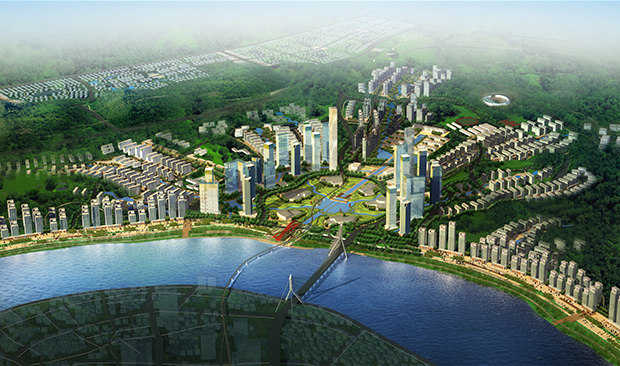
Chongqing Jiangjin North New Area: Sponge City Design from the Perspective of Landscape Urbanism
-

China (Hainan) Pilot Free Trade Zone of Haikou Jiangdong New District Conceptual
Urban Design of Sponge System Optimization
-

Construction of the Guangzhou Tianhe Smart City Sponge System
-

Construction of the Minneapolis Waterfront Sponge System
-

Xixian Fengxi New City Sponge City System Construction
Sponge System Planning Based on Existing Urban Layout
-

Kunming Dianchi River Greenway: Construction of a Linear Sponge System
-

Saudi Arabia Riyadh King Salman Park
-

Kunming Dianchi West Bank Ecological Infrastructure: Construction of a Mountain Lake Sponge System
Sponge System Planning
Micro Scale -- Green Sponge System Design and Case

Facing increasingly serious urban water shortage and stormwater problems, we should not only rely on urban scale planning, but also empower individuals to tackle the problem. Family water ecological infrastructure is the extension of national scale water ecological infrastructure. By using every family unit and community green space, green roof and courtyard to collect rainwater, more than 20% of residential land can become a green sponge and urban flooding will be greatly alleviated.
The performance evaluation platform focuses on demonstrating the comprehensive benefits of sponge city construction practices, systematically revealing their multidimensional value across environmental, economic, and social dimensions. Each case assessment is based on rigorous research, integrating key findings, reference sources, full-text links, and project details to provide convenient academic and practical previews.
We hope this resource not only supports your insights into the multiple impacts of nature-based solutions but also aids communities, clients, and policymakers in making scientific decisions. If you have more relevant research findings, you are welcome to share them with us at turen@turenscape.com or info@turenscape.com to collectively improve this ever-evolving platform and jointly promote the innovation and practice of sponge cities.


